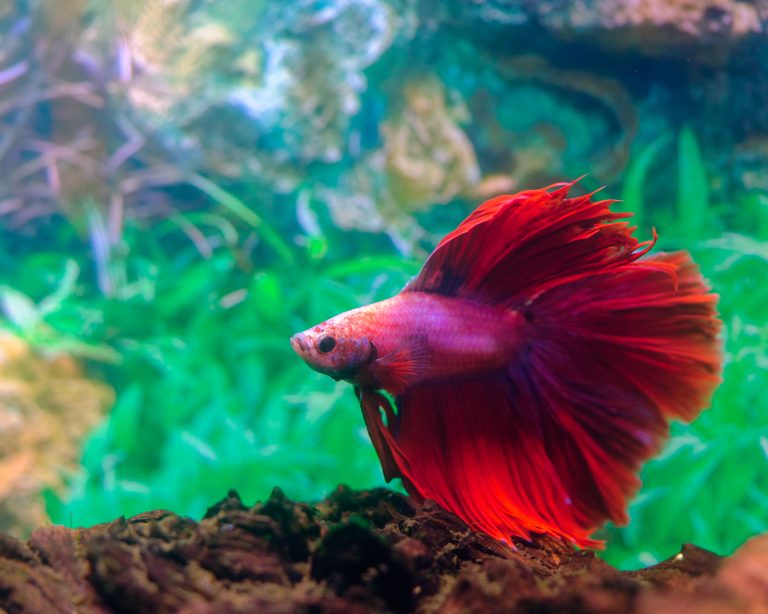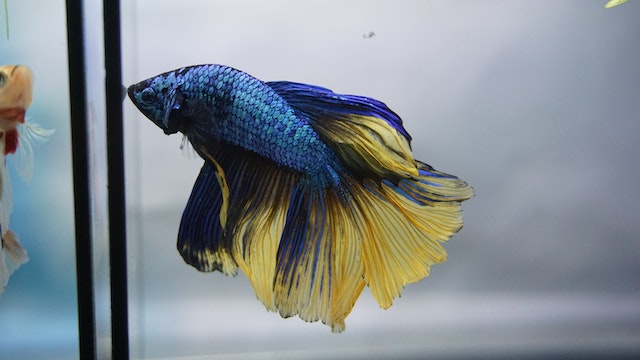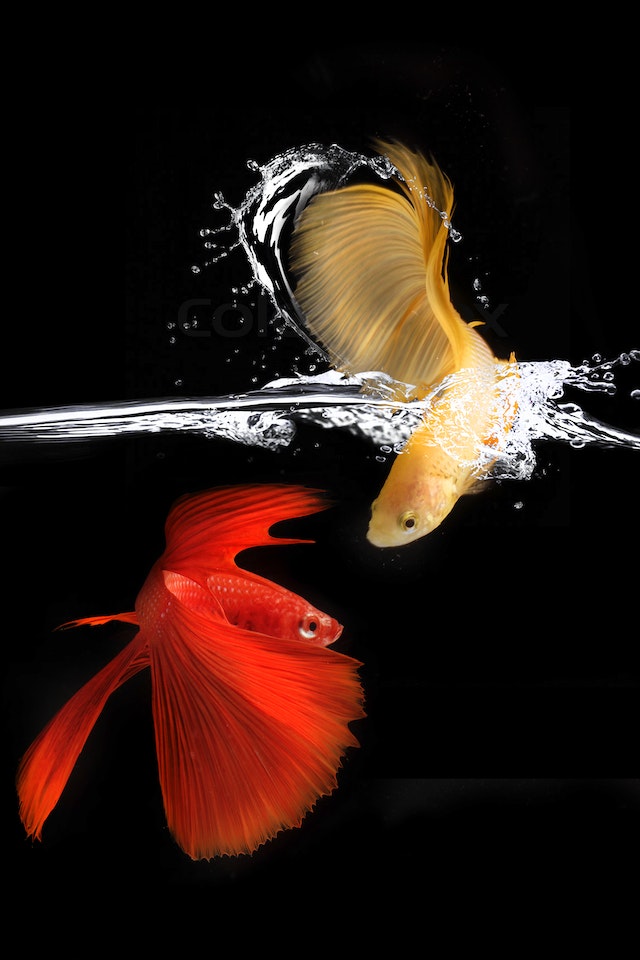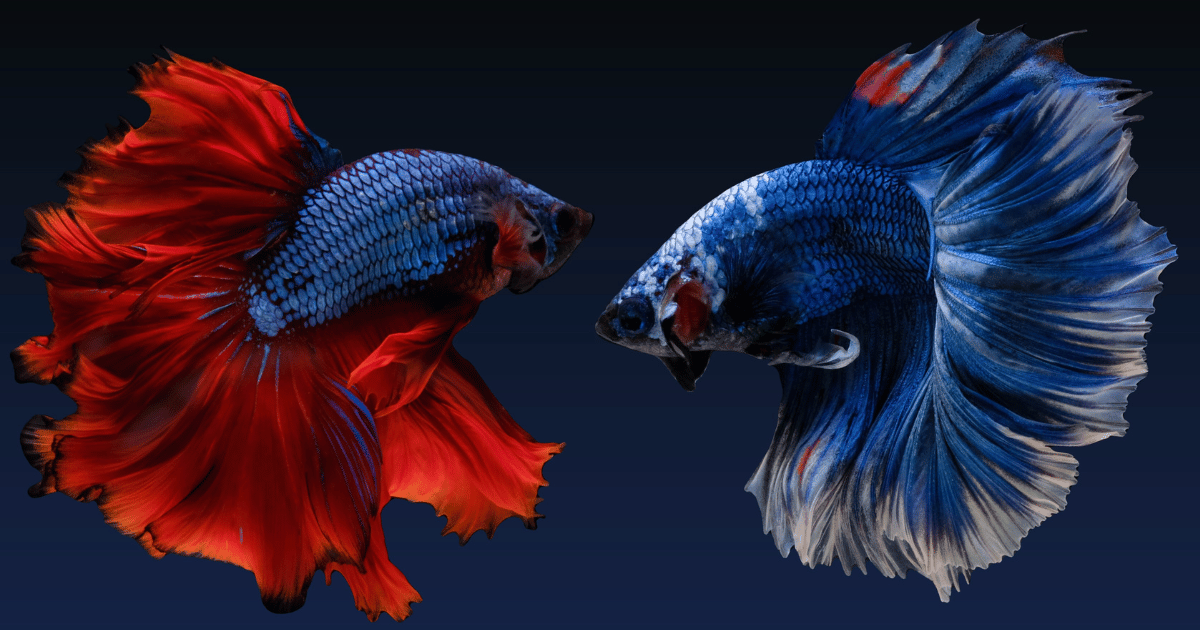Welcome to your definitive handbook on the care and keeping of the vibrant and alluring Betta Fish, a popular choice among freshwater aquarium enthusiasts for their stunning colors and unique personalities.
This guide has been meticulously crafted to provide you with comprehensive knowledge about this fascinating species.
Whether you’re a novice fish keeper exploring the idea of adding a Betta to your collection, or an experienced aquarist, this guide is designed to help you understand and meet the needs of your Betta Fish effectively.
 Brief about Betta Fish
Brief about Betta Fish
Betta Fish, also known as Siamese Fighting Fish, are renowned for their rich, vivid hues, dramatic fins, and a demeanor that’s as unique as their appearance.
They are a tropical freshwater species that hail from the Mekong basin of Thailand, Laos, Cambodia, and Vietnam.
Betta Fish are relatively small, typically measuring between 2 to 3 inches in length.
These striking fish are renowned for their territorial nature and the males are famous for their aggressive displays when encountering another of their kind. This behavior is a sight to behold, with flared gills, spread fins, and intense colors all coming into play.
Unlike many other popular aquarium species, such as the neon tetra or goldfish, Betta Fish are labyrinth breathers. This means they have the unique ability to breathe oxygen directly from the air, in addition to absorbing it through their gills. This adaptation allows them to thrive in low-oxygen environments that would be unsuitable for many other fish.
Betta Fish Origins
Origin of Betta Fish
The Betta Fish, or as it’s scientifically known, Betta splendens, is a freshwater species that has its roots deeply embedded in the rice paddies, marshes and slow-moving streams of Southeast Asia, notably Thailand.
The name “Betta” was derived from an ancient clan of warriors known as the “Bettah”. This is a fitting name as the Betta Fish is renowned for its fiercely territorial nature and unique fighting spirit.
The fish’s vibrant colors and flowing fins that you’re familiar with today are a result of extensive selective breeding. This is a far cry from their wild counterparts that are typically more dull-colored to blend into their natural surroundings.
Choosing Your Betta Fish
Different types and colors of Betta Fish
In your journey to becoming a Betta Fish connoisseur, you’ll marvel at the stunning assortment of types and hues of these aquatic wonders.
From the radiant, fiery red Betta to the tranquil, cerulean blue variant, the color spectrum of these fish is indeed a feast for the eyes. There are even multicolored Bettas, boasting a fascinating mix of vibrant shades that transform your aquarium into a living canvas.
When it comes to types, there’s an impressive variety to choose from. Some of the popular types include the Crown Tail Betta, with its spiky tail fin, the Halfmoon Betta, characterized by its 180-degree tail spread, and the Plakat Betta, known for its short tail.
Choosing a healthy Betta Fish
Selecting a healthy Betta Fish is paramount for ensuring its longevity and vibrant display. Here are some key indicators to help you choose a healthy Betta:
- Active Behavior: A healthy Betta Fish should be lively and responsive. If it darts about the tank when you approach, consider it a good sign.
- Bright Colors: Dull colors may indicate poor health or stress. Look for Bettas with vibrant, rich colors.
- Clear Eyes: The eyes should be clear and not cloudy. Cloudy eyes may signal an infection.
- Good Appetite: A healthy Betta should be eager to eat. Lack of appetite can be a sign of illness.
- No Visible Injuries or Abnormalities: Check for signs of injuries, spots, or growths on the Betta’s body. These could suggest disease or poor care.
While Betta Fish are fairly easy to care for, they still need the right environment and diet to thrive – much like the best freshwater fish for beginners.
By choosing a healthy Betta Fish and providing it with proper care, you’ll be well on your way to enjoying a vibrant, lively, and colorful addition to your freshwater aquarium.
 Betta Fish Care
Betta Fish Care
Caring for your Betta fish involves more than just feeding it daily.
Let’s delve into the specific aspects of Betta fish care that will ensure your underwater companion thrives in its new home.
Proper Tank Setup
When it comes to creating a comfortable home environment for Betta fish, the tank setup plays a crucial role.
Unlike other popular freshwater pets such as the goldfish that can adapt to bowl life, Betta fish require a spacious tank, preferably 5 gallons or larger. A tank that is too small can cause stress and health problems for the fish.
The tank should be equipped with a filter to maintain cleanliness and a heater to keep the temperature stable. Betta fish are tropical species and prefer a warm environment between 76 to 80 degrees Fahrenheit.
Incorporate plenty of hiding spots in your tank setup. Betta fish enjoy solitude and often seek refuge in caves or among plants.
Live or silk plants, as well as decorations that do not have sharp edges, are ideal for a Betta tank setup.
Ideal Water Conditions
Water quality can significantly impact the health of your Betta fish. They prefer slightly acidic to neutral pH levels, between 6.5 and 7.5.
Regular water changes, preferably once a week, are essential to prevent the build-up of harmful toxins.
When doing water changes, it’s essential not to change all the water at once, as this could lead to drastic changes in water parameters, which can stress the fish. A common recommendation is to change 20-30% of the water weekly.
Invest in a quality water testing kit to monitor parameters such as ammonia, nitrate, and nitrite levels. These should always be as close to zero as possible.
Proper Feeding
Feeding your Betta fish correctly is another critical aspect of their care. These vibrant fish are carnivores by nature and thrive on a diet rich in protein.
Betta fish pellets are a popular choice due to their nutritional balance. Supplement this staple diet with occasional treats such as brine shrimp, bloodworms, and daphnia.
It’s essential to avoid overfeeding, as Betta fish have small stomachs. A general rule is to feed them only what they can consume within 2 minutes.
 Health and Illnesses
Health and Illnesses
Keeping a close eye on your Betta fish’s health is vital. Common signs of illness include loss of color, lethargy, loss of appetite, and unusual swimming patterns.
Fungal and bacterial infections are common among Betta fish and can be prevented with good tank maintenance. If your fish shows signs of illness, it’s advisable to consult with a vet or an aquarium specialist.
Social Behavior
Understanding your Betta fish’s social behavior is key to ensuring its happiness. Betta fish, especially males, are known for their territorial nature.
They are often referred to as “Siamese fighting fish” due to their aggressive tendencies. Therefore, they should ideally be kept alone or with non-aggressive species.
However, female Betta fish are less aggressive and can be kept in groups, known as ‘sororities,’ provided the tank is large enough to prevent territorial disputes.
Your Betta fish can coexist peacefully with other species if introduced correctly. For instance, neon tetras are known to be compatible tank mates for Betta fish.
In conclusion, understanding the specific needs of your Betta fish is crucial to ensure its well-being. From the proper tank setup to understanding their social behavior, each aspect contributes to their overall health and happiness.
Breeding Betta Fish
Betta fish, with their vibrant hues and unique personality, have a fascinating breeding process that can be quite rewarding if you’re equipped with the right knowledge and patience. However, it is complex and typically not recommended for beginners.
Let’s delve into the world of Betta fish breeding.
When and How to Breed
Betta fish reach sexual maturity at around six months of age. However, it’s suggested to breed them when they’re between 10 to 12 months old, as they are most healthy and vibrant during this time.
Breeding Betta fish is not as straightforward as it is with some of the best freshwater fish for beginners. The process requires a set of specific conditions in the tank.
It’s essential to maintain water temperature around 80°F (27°C) and provide an area for the male Betta to build a bubble nest, usually by floating a piece of Styrofoam or a live plant at the water surface.
The dance begins with the male Betta displaying his full flair to attract the female. Once she’s ready, she will start releasing eggs and the male will fertilize them. The male then carefully collects the eggs in his mouth and places them in the bubble nest.
Caring for Betta Fish Fry
Post the breeding, the real challenge begins – caring for the Betta fry. At this stage, the male Betta takes the lead in caring for the eggs. It is recommended to remove the female from the tank, as the male can become aggressive in his protective role.
Once the eggs hatch, usually within 48 hours, the fry will feed off their yolk sacs. After this period, you can start feeding them with infusoria or liquid fry food until they’re big enough to eat brine shrimp nauplii or microworms.
The male should also be removed once the fry start swimming freely to prevent them from being eaten.
During this critical stage, maintaining optimal water conditions is crucial. Regular water changes, careful monitoring of temperature and pH levels, and ensuring a calm environment will help the fry mature into healthy and vibrant Betta fish.
It’s important to note that Betta fry grow at different rates and may exhibit cannibalistic tendencies. Therefore, be prepared to separate them into different tanks as they grow larger.
Breeding Betta fish can be a complex process, but with the right knowledge and care, it can also be a rewarding one. Just remember, patience and attention to detail are key.
In your journey of Betta fish breeding, you might find it interesting to learn about other fish breeding practices such as guppy care or platy fish care. Exploring these can enrich your overall experience in the vast and colorful world of aquariums.
Common Questions About Betta Fish Care
As you venture into the world of Betta fish care, it’s natural to have a plethora of questions. This section aims to address some of the most frequently asked questions regarding this stunning freshwater species.
How long does a Betta Fish live?
Betta fish, when cared for properly, typically have a lifespan ranging from 3 to 5 years. However, with exceptional care, some Bettas have been known to live up to 7 years.
This lifespan is contingent upon several factors including diet, tank conditions, and the overall health of your fish.
What to feed your Betta Fish?
Betta fish are carnivores by nature and require a diet rich in protein. High-quality Betta pellets should be the mainstay of their diet, as these are specially formulated to meet their nutritional needs.
In addition to this, you can provide treats such as freeze-dried or frozen bloodworms, brine shrimp, or daphnia. It’s important to avoid overfeeding, as this can lead to health issues.
A general rule of thumb is to feed your Betta an amount that it can consume within 2 minutes, once or twice a day.
Can Betta Fish live with other fish?
Betta fish are known for their territorial nature, particularly the males. However, they can co-exist harmoniously with other fish, provided certain conditions are met.
The chosen tank mates should not be aggressive or too active, as this can stress your Betta. Species such as Neon Tetra or Molly fish can be good companions due to their peaceful nature.
Moreover, the aquarium should be spacious enough to allow each fish to establish its territory. It’s also advisable to have plenty of hiding spots in the tank in the form of plants or decor to prevent any potential conflict.
Remember, the well-being of your aquatic pets should always be the top priority. If you notice signs of stress or aggression, it may be best to house your Betta separately.
In conclusion, Betta fish care requires a fair amount of knowledge and dedication. But with the right information, you can ensure a happy and healthy life for your aquatic companion.

